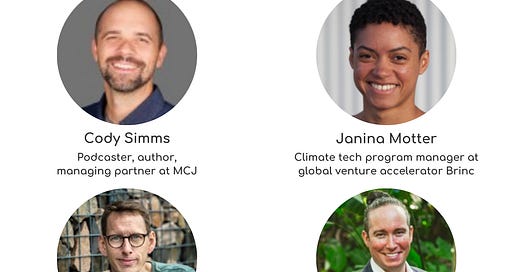Fundraising for climate tech startups in 2025 isn’t what it used to be. A few years ago, venture investors were swimming in capital, willing to take risks on big, bold ideas. Now? The pool has shrunk, standards are higher, and it’s more crowded than ever.
For founders, this means one thing: mastering how you tell your story is more important than ever. Success isn’t just about having a great idea or impressive traction; it’s about communicating your vision in a way that resonates with the diverse, sometimes unpredictable, expectations of investors.
And it’s not just about the pitch deck anymore. Today’s climate startup founders must master storytelling across multiple formats and lengthy timeframes — while also understanding and adapting to the diverse preferences and motivations of angel and VC investors.
To help founders tackle these challenges, we spoke with four brilliant insiders:
In this two-part series, we’ll unpack their insights on the current climate startup fundraising landscape. Let’s go!
Understanding the Investor Landscape
It’s no secret that the current venture fundraising environment is tough. Climate funds are making hard decisions about limited capital, and according to Motter, many generalist funds are scaling back their involvement in the space, especially for hardware.
Investors aren’t one-size-fits-all, so neither should your communication strategy be. They differ in accessibility, involvement, process, deal stage, and priorities. As a founder, understanding who you’re approaching and what they care about is essential to standing out.
“Are you pitching someone who’s investing primarily for the impact outcomes? Are you pitching someone who frankly is a cold-hearted capitalist, but just believes that this is the right business model to win? How you position your story accordingly is important.”
–Cody Simms
Impact funds are looking for both positive financial outcomes and impact oriented metrics (often specific ones). Many generalist funds also invest in technologies they believe will be world positive, either because they are somewhat mission driven or simply because they believe it’s a good financial bet.
Beyond impact or profit-driven motivations, there are vast differences in how venture investors approach the founder relationships — and those differences matter for founders.
“There are so many types of VCs, but still, a lot of them are started by middle-aged men from a very privileged background, and they don't want to do tons of work. They're in it for status and getting wealthier,” shares Hampus Jakobsson.
He continues, “They hire an army of young enthusiastic people and tell them, ‘Go out and find opportunities.’ Some will never even want to meet founders, and others may want to take you skiing for a weekend and then decide whether to invest. Either way, for founders it often seems like there’s no rhyme or reason to the decisions.”
Jakobsson strongly advises founders to think carefully about the investors they approach.
“A lot of founders want to go after the big money and the big logo to look important. And maybe they offer you $10 million, because you know some friend of theirs. But the problem is, they won’t work and engage. You only get their money, and none of their experience. Meanwhile, a less glamorous fund might offer $6 million. But the partners get what you do, they like you, you like them. I think you’re going to be so much better off.”
It can take some digging to get pertinent information about potential investors. Some VC websites clearly outline basics like their target sectors, check sizes, and regions served. If not, use databases like those at VCSheet or OpenVC. Incubators and accelerators can also be great resources for checking both practical and cultural fit. And it’s also a good idea to connect with portfolio companies of your target funds.

Tailoring Your Approach
Climate-focused funds are more selective than ever, and founders often underestimate how many investors they need to reach to close a round.
Janina Motter explains, “A lot of founders think, ‘I need to find investors who already get my space, and the technology.’ You can try that, but then there aren’t as many people you can contact, and those few investors are seeing all of your competitors. So you’ll still need to tell a very clear story of how what you're doing is differentiated.”
She adds, “It's an extremely tough fundraising environment right now. We hear startups reporting having to contact 2–300 investors, and processes up to 18 months — and that's for a company that's doing well and has some good traction.”
It’s worth noting that venture capital has been largely constricted across the board for some time, not just in climate tech. Forbes reports that while deployment did grow by 20% in 2024, “the focus has shifted back to fundamentals—profitability, sustainable growth, and scalable innovation…speculative bets on unproven technologies are waning.” As much of climate tech falls into that category, the headwinds seem likely to continue in the months ahead.
Takeaways:
Do your homework: It might sound obvious, but many founders neglect the research and pitch to VCs who aren’t a match.
Leverage warm intros: Personal recommendations from accelerators, founders, or shared networks can open doors. As Justin Brodie-Kommit notes, he partners with accelerators to connect with founders, using one-on-one meetings to build context before entering formal pitch processes.
Accessibility matters: Fundraising is essentially a sales process, and that means reaching decision makers is best. If you can only reach a junior associate, ask what the decision process tends to look like. Evaluate the situation and decide if it’s worth your energy to pursue. You may still be able to win the deal, but as Jakobsson noted, it can be a confusing experience.
Engage beyond capital: Look for investors who offer mentorship, connection, or feedback, not just funding. “I try to be a value-add even before I write a check, helping founders refine their pitch or connect with resources in my network,” says Brodie-Kommit.
Common Communication Mistakes and How to Avoid Them
Fundraising success isn’t just about the pitch — it’s about how you communicate at every step. Here are the most common mistakes founders make, along with expert advice for avoiding them:
1. Poor Conversation Tracking
“Founders often don't have a great way of tracking the progress of conversations. They get trapped in cycles where either they lose touch and aren't following up with investors, or they don't realize when investors have lost interest,” explains Motter.
Solution: Use a CRM or database to track investor interactions. Motter also suggests using newsletters to keep investors engaged and monitor who’s opening them.
2. Tech Overload
Climate founders often don’t realize how tech-heavy their communication style is — and how unrelatable that is for investors and others. It can also overshadow the business case and emotional connection that need to be made.
“Tech startups, especially early-stage ones, tend to lean too heavily on the tech they're building and don't communicate enough about what they've learned from customers,” says Simms.
To be fair, some investors want all the technical details. Brodie-Kommit, who is soon launching a new fund called Lichen Venture, explains: “I personally have a heavy interest in technology and love using my deeply technical expertise to understand and de-risk as I build conviction around an investment. ”
3. Impact Storytelling
Climate investors often allocate their funds across multiple sectors and technology types, which means more competition for startups, especially in the current environment.
“Founders are competing against not only their direct competitors but all kinds of other climate solutions. So the bar becomes very high for telling a truly compelling story around the scalability of their climate impact,” says Motter.
On the other hand, too much impact emphasis can leave potential investors without the clear path to profitability and scalability they’re looking for (especially more generalist investors).
“It's one thing to get me to believe that the world needs your solution. It's another to get me to believe your company is going to successfully bring it to market.”
–Cody Simms
Simms continues, “If you're building a startup, you're not writing a dissertation. You need to communicate how and why the customers you think you’re going to target want this — and how you're going to go get them. That is drastically under-emphasized in a lot of early-stage climate tech communication.”
4. Poor Preparation
Generic materials or sloppy pitch decks can derail investor relationships. “If the deck is just too wordy and not really presentable, it signals a lack of reliability,” says Brodie-Kommit.

And polishing the wrong things can be worse than staying simple and basic. Jakobsson recalled a pitch deck with an outdated style that focused too much on trivialities like exact numbers with multiple decimal points — something better left to the diligence process.
“When I opened this deck,” Jakobsson says, “my first impression was, I wish they spent either less time on design or more. It seemed like they didn't really understand investors as a target group.”
5. Entitlement
Founders who approach investors with arrogance or disrespect can not only lose investments but also sustain reputational damage as VCs share experiences.
Jakobsson shares: “We don't want to see privilege and douchebaggery. Often when people send a deck and we decline, they respond, ‘I don't think you know what you’re doing. You don't know who I am.’ And so on. And we feel very blessed that we didn't spend any time with this person. If you're a female investor, it’s even worse and more common: ‘I don't know what you're doing honey, but I'm a PhD in this subject.’ It’s terrible.”
6. Business Model Issues
Brodie-Kommit highlights additional issues related to the scope and scalability of the business idea:
Undersized problems or markets: “Some founders focus on niche issues or ideas that don’t address large-scale problems. Venture capital typically requires companies to aim for transformational change — not just incremental improvement.”
Unclear path to scale: “We see companies with great concepts, but they don’t really fit the venture-backable model. If there’s no clear way to grow rapidly and significantly, it’s hard to justify the investment.”
Entering overcrowded markets: “We get a lot of inbound messages from startups targeting completely saturated areas. It can work, but it’s harder to stand out. And we want to see more companies build solutions for under-addressed emissions gaps or underfunded areas of resilience and adaptation.”
Key Takeaways for Founders
Know Your Audience: Tailor your pitch to their goals and preferences.
Focus on the business case: technical detail and climate impact matter, but credible scalability and ROI matter most
Balance Confidence and Humility: Investors want partners they trust, not just impressive ideas.
Stay Persistent: Fundraising takes resilience and strategy.
In Part 2, we’ll dive into essential messaging assets and actionable strategies for fundraising success. Stay tuned—and if you found this article helpful, please share it with your network!
Editor Credit: Kate Bubacz






